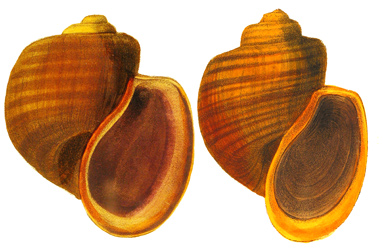(Reeve, 1856)
Synonym (obsolete): Ampullarius australis
(Reeve, 1856) Synonym (obsolete): Ampullarius australis
|
Pomacea bridgesii (Reeve, 1856) and Pomacea diffusa (Blume, 1957) have
long been considered to be a single species. Nowadays, they are considered to
be distinct species based on mitochondrial DNA analysis. Pomacea bridgesii
(Reeve, 1856) is a rather rare species that is known to inhabit a small range:
the Rio Grande, Reyes River at Beni (bridges). Pomacea diffusa
(Blume, 1957) is much more common and inhabits almost the entire Amazon river
system. It's also the latter that is common in the aquarium trade.
Pomacea bridgesii is rather large (65mm shell height and more), while
Pomacea diffusa is much smaller, has a much more pronounced spire and
a darker shell colour.
 Pomacea bridgesii from Conchologia Iconica, or Illustrations of the shells of molluscous animals, Reeve, 1856. |
Pomacea bridgesi or Pomacea bridgesii?
In the
original description of this Pomacea species, Reeve (Conchologica
Iconica, X, plate 3. August 1856) appearantly intented to name the snail as
"the ampullaria from Bridges" or "Bridges's ampullaria".
Because species are given a Latin name, Bridges was seemingly translated to
bridgesius prior to conjugation and thus the name became: "Ampullaria
diffusa (bridgesii)".
Shell: The shell of this apple snails
species has about 5 to 6 whorls. The most obvious characteristic of the shell
are the square shoulders (flat at the top of the whorls) and almost 90°
sutures. The shell opening (aperture) is large and oval, the umbilicus is
large and deep.
The size of the shell varies from 50-60 mm wide and 60-70 mm high. The spire
is high and sharp, hance the often used name: spike-topped apple snail.
The colour varies from yellow, green to brown, with or without dark spiral bands.
|
Interactive 3D-models (Java): |
Operculum: The operculum is moderately thick and corneous. The structure
is concentric with the nucleus near the centre of the shell. The colour of the
operculum varies from light to dark brown. The operculum can be retracted in
the aperture (shell opening).
Body: As with the shell, many variations exist: from light yellow (cultivated)
to almost black with yellow spots on the mouth.
Eggs: The pale pink to reddish eggs are deposited above the waterline and are closely attached to each other. Their size varies from 2.20 to 3.5 mm (0.5 to 0.9 inch) diameter. An average egg-clutch contains 200 to 600 eggs.
Food: Unknown.
Behaviour: moderately amphibious animal; relatively inactive during the
day; can often be found on the bottom where it's searching for food or remains
hidden in the mud; most activity during the night.
Distribution: Only reported at Rio Grande, Reyes River at Beni.
Similar to: Pomacea diffusa
and Pomacea scalaris, to which it's
probably close related to. In Pomacea scalaris,
the shell shoulder is much more angulated, in such extent that it almost carinated.
Pomacea scalaris lives more to the
south (Argentina and South Brasil). However Reeve (1856) described Bolivia as
habitat of Pomacea scalaris as well. Pomacea diffusa
(Blume, 1957) is common throughout the Amazon Basin (Brazil, Peru, Bolivia)
and is present in the aquarium trade.
|
Except where otherwise noted, this page is licensed under a Creative Commons Attribution-NonCommercial-ShareAlike 2.5 License . http://www.applesnail.net |
|